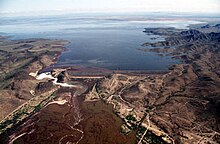Painted Rock Dam
| Painted Rock Dam | |
|---|---|

Photo taken during period of high runoff, with the resultant reservoir completely full and verging the emergency spillway
|
|
|
Location of Painted Rock Dam in Arizona
|
|
| Official name | Painted Rock Dam |
| Location |
Maricopa County, Arizona, United States |
| Coordinates | 33°4′22″N 113°0′56″W / 33.07278°N 113.01556°WCoordinates: 33°4′22″N 113°0′56″W / 33.07278°N 113.01556°W |
| Construction began | 25 July 1957 |
| Opening date | 18 Jan 1960 |
| Construction cost | $13,670,000 |
| Operator(s) | United States Army Corps of Engineers |
| Dam and spillways | |
| Impounds | Gila River |
| Height | 181 feet (55 m) |
| Length | 4,780 feet (1,460 m) |
| Reservoir | |
| Creates | Painted Rock Reservoir |
| Total capacity | 2,491,700 acre feet (3.0735×109 m3) |
| Painted Rock Reservoir | |
|---|---|
| Location | Arizona |
| Coordinates | 33°4′22″N 113°0′56″W / 33.07278°N 113.01556°W |
| Type | reservoir |
| Primary inflows | Gila River |
| Primary outflows | Gila River, evaporation |
| Catchment area | 50,800 sq mi (132,000 km2) |
| Basin countries | United States |
| Surface area | 53,200 acres (215 km2) (maximum) |
| Max. depth | 181 ft (55 m) |
| Water volume | 2,491,700 acre·ft (3.0735 km3) (maximum) |
| Surface elevation | 661 ft (201 m) |
The Painted Rock Dam is an earthfill embankment dam located west of Gila Bend, Arizona. It is primarily used for flood control purposes.
The Painted Rock Dam was constructed during a 3-year period from 1957–1960 by the United States Army Corps of Engineers to help control seasonal floods on the lower reaches of the Gila River. The river had no significant impediments between the Colorado River and the Coolidge Dam hundreds of miles upstream. In this stretch the river receives several tributaries, including the Hassayampa, Agua Fria rivers, and most importantly the Salt River and its major tributary, the Verde River. Due to a relatively large watershed of 50,800 square miles (132,000 km2), more than half of which is unregulated, the flood threat to small farming communities downstream on the Gila River is large, and seasonal flooding of these areas prior to the construction of the dam was significant.
The area surrounding the dam has also hosted a number of historical events. The Butterfield Overland Mail route passed through the area, as did the path followed by the Mormon Battalion. Evidence of both can be found, as well as the expedition of Juan Bautista De Anza in 1774. Inscriptions made by these groups can be found in various sites in the region.
Near the dam site, there is also a campground maintained by the Bureau of Land Management that showcases a number of prehistoric petroglyphs, indicating human involvement in the region long predating Western influence. It is from the Painted Rock Petroglyph Site that the area and the dam get their names.
...
Wikipedia

